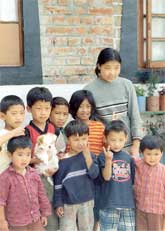Educational organization of the Children’s Villages

A group of Tibetan children stand oustide their home in the Tibetan Children´s Village. The home is one of around 40 in the village.
The educational organization of the Tibetan Children’s Villages is strikingly similar to that with which we are familiar in the United States. After evolving from a simple nursery into a full-fledged and internationally recognized system of boarding schools, the TCVs have become the preferred method of education for the Tibetan child.
The kindergarten of the TCV accommodates the children ages three to five years and follows the Montessori method of teaching; the students engage in more activity and skill-oriented programs with a Tibetan cultural focus. From that program, the children graduate to the Junior School, grades one through five.
The Junior School initially followed the Indian school model and curriculum, which required that classes be taught in English. This changed in 1984 when the Tibetanization program was introduced. Tibetanization sought to battle the loss of Tibetan culture and identity by teaching the basics of elementary education in the Tibetan language, in conjunction with an intensive cultural study. The Education Development and Research Center of the TCVs began to write and publish textbooks in Tibetan at this time. Basic subjects like math, science and language arts, along with textbooks on Tibetan culture and language are revised and reviewed periodically by the EDRC and specialized committees.
Beginning with grade six, the language of instruction is gradually replaced by English. The sixth, seventh and eighth grades represent the Middle School, in which there is a combination of Tibetanization and Indian curriculum and Tibetan and English language.
The syllabus becomes strictly Indian in the Senior School, for students in grades nine through twelve. The Indian Central Board of Secondary Education administers a national exam to students in their tenth year, a requisite of all students receiving primary education in India.
The Plus Two program is reminiscent of the European style of higher education, in that it offers vocational and collegiate preparation in the form of two optional years of schooling following the tenth year. These two additional years, grades eleven and twelve, respectively, are referred to as the Plus Two level of Tibetan education. Should a student opt to attend the Plus Two program, the student is asked to choose from three specializations: humanities, commerce or science. From the Plus Two program, a student is free to pursue a preferred vocation or higher education in Indian universities.
The ratio of male to female students in the TCVs is nearly equal.
The dropout rate of less than 5 percent, and the literacy rate among schooled Tibetans is 98 percent. Relative to an American literacy rate of 97 percent, a British rate of 99 percent and a German rate of 99 percent, the Tibetan literacy rates are comparable on a world scale.
Your donation will support the student journalists of Missouri Southern State University. Your contribution will allow us to purchase equipment and cover our annual website hosting costs.



























